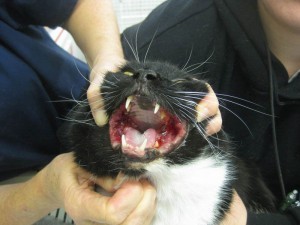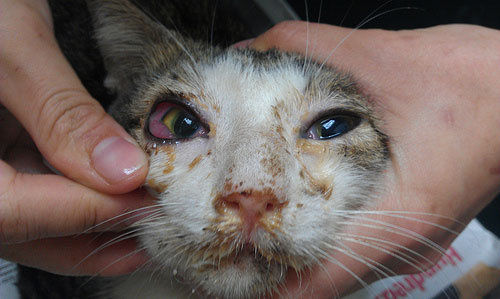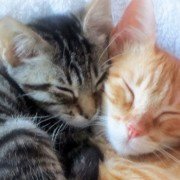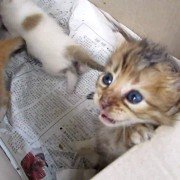Understanding Cat Flu – Full Article
Most people who have worked with cats have seen cats with runny, pusy eyes and noses, sneezing and sometimes being quite unwell. This is ‘cat flu’ (picture 1). Despite a short name it is a complex disease process as it is not caused by just one bug. 80% of cases are caused by either Feline Calicivirus (FCV) or Feline Herpesvirus (FHV) or both together. Then there are a whole host of other infectious agents that can ‘jump on the band-wagon’ taking advantage of the cat’s vulnerable status.
It is extremely common in unvaccinated cats, especially when there are lots of cats together in one place. It has a high morbidity rate (numbers of cats infected that get ill), but a low mortality rate (number of infected cats that die as a result of infection). Cats with poor immune function are more likely to have serious illness and possibly die, e.g. cats that concurrently have FIV or FeLV, elderly or malnourished cats, or kittens with low natural immunity against the viruses.
(See ‘Glossary’ for abbreviations or words in red for definition)
Transmission
Both FCV and FHV are passed on from infected cats in their saliva, snot and sneezes. Thus, close or direct contact is generally required for transmission, via sneezing, mutual grooming, or sharing food and water bowls. However, unlike FHV which only lasts 1-2 days outside a host, FCV can survive in a dry environment for a month and is also resistant to many disinfectants, making it possible for a cat to become infected via fomites, rather than direct contact.
Symptoms
The two viruses can cause some similar symptoms – the typical ‘cat flu’ signs of upper respiratory tract infection and fever, occasionally leading to pneumonia, but they also have their own particular sets of symptoms too.
FHV can cause corneal ulcers, and can result in chronic rhinitis (those cats that just keep on sneezing).
FCV often causes ulcerations in the mouth which can be very painful (picture 2 – author’s own cat Mikey as a kitten). It can also cause ‘limping syndrome’ due to inflamed joints, which is usually short lived. It is also associated with chronic gingivostomatitis, where the gums and soft tissues of the mouth can be incredibly sore and inflamed (picture 3). There have been some outbreaks of ‘Virulent Systemic FCV’ in Europe and USA. This nasty form of FCV infection causes fever, skin swelling, ulcerations of the head and limbs, liver disease, pneumonia, sometimes embolisms, and often death. Fortunately it is not common.

Typical appearance of a cat with signs of ‘flu’
(from http://www.catwelfare.org)
Then what happens?
Outcome of FHV & FCV infection can vary widely. In otherwise healthy cats, symptoms usually resolve spontaneously within 1-2 weeks. FHV can still be shed by the cats, despite recovery, for about 3 weeks, and FCV for about 1 month, possibly longer.
Unfortunately, both viruses can remain in some infected cats for life. These cats (called asymptomatic carriers) may not have any symptoms but still shed the viruses, potentially infecting other cats. They may also suffer relapsing symptoms, especially if they are stressed, or given immune suppressing drugs like steroids.
As well as FHV and FCV, cat flu can be complicated by secondary infections. Commonly, the following bacteria and other organisms are the culprits: Chlamydophila felis, Mycoplasma spp., Bordatella bronchiseptica, and Pasteurella multocida. Chlamydophila felis is worth special mention, as it is not killed by the antibiotics that are usually given. It causes conjunctivitis, often with very puffy eyelids, and requires special treatment preferably with doxycycline orally for 4 weeks, plus tetracycline based eye ointment. Using eye drops/ointment alone will not fully clear the infection.

Ulcers visible along edge of tongue
(H. Gunn)
How can cat flu be treated?
Although antibiotics are usually given to cat flu cats, these are only to help with the secondary infections, they do not kill the viruses. There are some anti-herpesvirus treatments available, which can be useful for severe cases or refractory cases such as non-healing eye ulcers. Oral famcyclovir can be given, and anti-herpes eye ointments are available. There are no safe anti-FCV drugs available. So, it’s really down to the cat’s own immune system to fight them off.
Other supportive medicines can be given to help make the cat feel better. Anti-inflammatories (eg meloxicam, ketoprofen, tolfenamic acid) can be used only if the cat is well hydrated, to reduce fever and inflammation. A mucolytic drug (breaks down mucus) called bromhexine (Bisolvon) can help clear the thick snot. Appetite stimulants (mirtazapine, cyproheptadine) are useful if the cat is very inappetent, and multivitamin supplements can be given too.
There have been some other treatments suggested for FHV and FCV infections, some have been put through clinical trials, others have not, but none have been shown to be significantly effective. These include Feline Interferon Omega (Virbagen Omega), Human Interferon Alpha, and L-Lysine (for FHV).
The crux of treating cats with flu however (those that can be handled), is good old fashioned Tender Loving Care. Cleaning the eye and nose discharges will make them feel so much better, keeping them in a warm, quiet environment away from other stresses – such as dogs or lots of noise and commotion, will help speed their recovery.
As cats’ appetites are heavily dependent on their sense of smell, being all bunged up tends to lead to inappetence. Therefore, steam vapour can help unblock the airways – provide a bowl of steaming hot water near the patient (ensuring it cannot be knocked over) several times a day. Nebulisers used for babies can also be used. Please do NOT use Olbas Oil or Menthol– cats are very sensitive to these substances – they can irritate and burn their delicate eyes and noses.
Use particularly smelly foods and warm it up a bit to create a strong aroma. There are not many cats out there who can’t resist some warmed sardines in tomato sauce (oddly they do seem to prefer the ones in tomato sauce over the ones in just oil!). Encouraging cats to eat by finger-feeding, or even syringe feeding liquid food may be necessary. It is really important they get nutrition on board, to have the strength to get better. Also, if cats starve completely for as little as a few days they can go into a form of liver failure called hepatic lipidosis.
Supportive fluid therapy is equally important. Some severely debilitated cats should ideally go on a drip at a vets, but if this is not possible, syringing water and electrolyte solutions orally is important.

Gingivostomatitis affects the soft tissues of the gums and mouth (from felinevet.net)
Prevention
Vaccinating cats certainly helps. The ‘flu’ vaccines are a combination of FHV and FCV. Generally, kittens, or cats that have not been vaccinated before, require a course of 2 injections, given 3-4 weeks apart, then importantly, a booster 1 year later. Kittens are usually started from 8-9 weeks of age. After that, re-vaccination frequency depends on their risk of infection – outdoor cats should be boosted annually, totally indoor cats can be done once every 3 years. Vaccination is not 100% effective, particularly the FCV vaccines, as the virus changes itself frequently, thus can evade the normal immune system responses.
In kittens, any antibodies against the viruses that they received from their mother’s milk (maternally derived antibodies – ‘MDA’) can interfere with the vaccinations. Unfortunately, how long MDA last in each kitten’s body varies widely, from as little as 4 weeks up to 16 weeks. Thus, there could be a 4-week window where the kitten has no protection before its vaccinated (hence why we often seen kittens develop cat flu around 4-6 weeks – usually infected by their own mothers). Conversely, it may have MDA interfering with both of its kitten jabs given at 8 and 12 weeks, leaving it unprotected thereafter.
To attempt to combat this in high risk situations, it is possible to start vaccinations from 4 weeks of age and give repeated vaccinations every 3-4 weeks until 16 weeks of age. Although this obviously increases the cost of vaccination, lots of shelters now do this protocol, as the benefit of reducing outbreaks of flu outweighs this cost. Veterinarians involved with vaccinating cats in this manner must be aware of the different types of vaccine, and what types are safe to use like this. This is classed as ‘off-label’ use of the vaccines, meaning the manufacturers have not licensed them to be used in this way.
There are several scenarios whereby infection can be spread within a household/shelter, and here it is important to remember that asymptomatic carrier status described above.
- You have healthy cats and are introducing a new apparently healthy cat into the house. Any of these cats could be asymptomatic carriers, and the other cats may not have adequate immunity. The asymptomatic carrier could be shedding virus, and infect the other cats.
- You have healthy cats, and are bringing home a sick cat to nurse it. The sick cat will undoubtedly be shedding virus and your resident cats may not have adequate immunity.
- Your resident cat(s) has/have had cat flu recently and you are bringing home a new cat.
- You run a shelter for rescued cats with new arrivals coming all the time.
Any of these scenarios can result in spread of infection. Prevention of spread is a 3 pronged system of quarantine, cleaning and vaccination.
Any new ‘healthy’ arrivals should be quarantined for at least 2 weeks, preferably 3, allowing time for infection to manifest itself should it be brewing. During this time, they should be vaccinated as soon as possible. Any cats with signs of cat flu should be isolated away from non-symptomatic cats. Any queens about to kitten, or with young kittens already should be isolated.
Cleaning any cleanable surfaces with products that will kill FCV is important – it lasts 30 days in a dry environment, and is not killed by all disinfectants. Suitable cleaning solutions are sodium hypochlorite (5% bleach, diluted to a 1 in 32 dilution), potassium peroxymonosulphate (eg Virkon S), chlorine dioxide, or other specific anti-virus disinfectants. Follow product guidelines carefully in terms of how to make it up, how long it should remain in contact with surfaces, and if rinsing off is required. If you use household bleach, be sure to rinse this off thoroughly, as cats are very sensitive to it.
Try to prevent spread by personnel – eg at a shelter with multiple staff, keep staff members working in one area only. If it’s just your house- feed, clean and handle healthy animals first, then sort out the sick ones, wash hands between the different groups, and if possible change clothing, or wear overalls kept solely for that group.
Sneeze barriers – solid glass or plastic – are better than metal cages at a shelter or cattery, they prevent transmission by sneezing- a cat’s sneeze can only travel one metre!
These are the ideal standards, and it many circumstances it is just not possible to do all this, but the closer to this the better. The number of cats in a given space, and lack of airflow within that space, are major factors for the spread of cat flu.
Claire Zentveld, BSc., BVM&S, GPCertFelP, MRCVS
Glossary
FIV – Feline Immunodeficiency Virus
FeLV – Feline Leukaemia Virus
Fomites – Any surface or substance that acts as a means of transmission of disease – includes environmental objects – cages, beds, food/water bowls and personnel – our hands or clothes.















Leave a Reply
Want to join the discussion?Feel free to contribute!